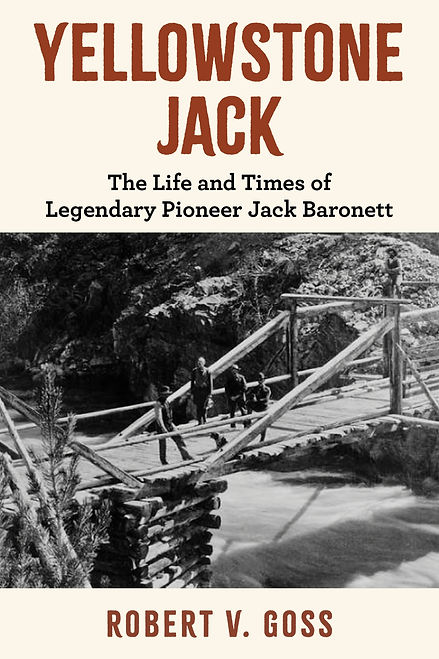


Yellowstone Jack
The Life and Times of Legendary Pioneer Jack Baronett
By Robert V. Goss
Paperback Imprint: Riverbend Publishing
-
-
Publication date : September 16, 2025
-
Language : English
-
Print length : 216 pages
-
ISBN-10 : 1493091824
-
ISBN-13 : 978-1493091829
-
Available from Amazon and other vendors,
Historians have dubbed Baronett prospector miner, explorer, adventurer, soldier of fortune, scout, hunter, guide, and Indian fighter—all monikers befitting his adventurous wanderlust life. Despite all these wanderings, he eventually discovered what would be his true home—southwest Montana and Yellowstone National Park.
Jack Baronett was an important figure in the history of Yellowstone National Park. In his early life he traveled the world, prospecting and mining in Australia, Africa, China, and Alaska. He traveled to the Yellowstone region in 1864—eight years before the Park was established—to join other early prospectors searching for gold and exploring the geyser basins. His first claim to fame came in 1869 when he and a partner rescued Truman Everts, a lost, near-death member of the Washburn-Langford-Doane Yellowstone expedition. After 1872 he served as early assistant superintendent in Yellowstone, a scout for the US Army, and one of the founders of Cooke City, MT. As a notable guide in the park, his patrons included Generals Sherman, Sheridan and Strong, President Chester Arthur, George Bird Grinnell, and William Henry Jackson. They all used Baronett’s Bridge, the first bridge built over the Yellowstone River in 1871. When news of the 1897 Alaska Gold Rush became known, Baronett joined the thousands of hardy and stalwart miners shipping north in search of gleaming fortunes. But would he be successful?
Robert Goss dedicated over thirty-five years working in and around Yellowstone National Park while living in Gardiner, Montana. He was employed by the Yellowstone Park Co. and its successors for thirty years before retiring from Xanterra Parks & Resorts in 2010. Additionally, he served as purchase agent for an underground gold mine at Jardine, Montana, formerly known as Bear Gulch. With this experience, he became familiar with local and Cooke City mining history.
An avid historian, he has studied and researched Yellowstone history extensively. Mr. Goss has self-published seven books that focus on the early concessioners and pioneers. He also authored or co-authored twenty-three articles featured in Yellowstone History Journal, Yellowstone Science, Annals of Wyoming, Motor Coach Age, Points West, Montana Pioneer, and other publications. He also co-authored Arcadia Publishing: Images of America - Livingston Montana with Elizabeth A. Watry.
For media inquiries, please contact Alyssa Griffin: agriffin@globepequot.com.
Built in the spring of 1871 by Collins Jack Baronett and some miner friends, his bridge is believed to be the first bridge built across the Yellowstone River. “Yellowstone Jack” also went by John H. Baronett, sometimes spelled Baronette, Gone for over 100 years now, the bridge was located about 200 yards upstream from where the Lamar River empties into the Yellowstone. It was built as a toll bridge for the miners, hunters, and freighters traveling to the mines of Cooke City. The operation, including Baronett’s nearby cabin & outbuildings cost about $4,000.
During the Nez Perce war of 1877, much of the log work was burned. Jack Baronett and Philetus W. Norris partially rebuilt the bridge in the following year. During much of this period of time Baronett was off on many gold prospecting expeditions in various parts of the West, and partners John Ponsford and J.L. Sanborn operated the toll bridge for him. In 1880 Baronett replaced the stringers, floor braces, and iron work at a cost of $2,000. In the early 1890s the government later refused to issue him a permit to continue operating the bridge and the Army summarily took possession of the structure in 1894. It continued to be used until a new bridge was constructed upstream in 1903. The old bridge was finally burned around 1906 and torn down in 1911. After a prolonged and expensive legal battle, Baronett received $5,000 from the government for his bridge. Traces of the old Baronett Bridge remain today, along with the old road into Yancey’s Hole.
